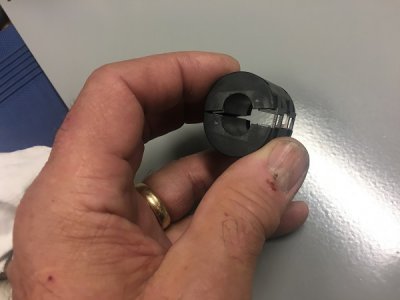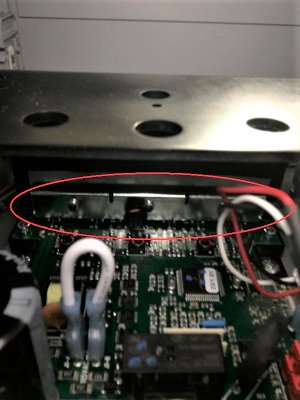I just finished a restoration of an old family lathe and added many upgrades. Among them was a three-phase motor with VFD and two iGaging Absolute DROs. The build thread is here.

 www.hobby-machinist.com
I can be pretty handy with mechanical things but electronics is definitely not one of them…..as I’m sure I’m about to convince you. The following is a bit windy, but just trying to efficiently converge on a solution.
www.hobby-machinist.com
I can be pretty handy with mechanical things but electronics is definitely not one of them…..as I’m sure I’m about to convince you. The following is a bit windy, but just trying to efficiently converge on a solution.
I used a small chain drag cable carrier for the DRO install to protect the cables. Here is a direct link to the DRO install portion of the thread.

 www.hobby-machinist.com
Unfortunately, that consumed most of the available DRO cable length, so I figured I’d just buy a couple cable extenders to remedy that. The DRO control cable connections are Micro USB, and the power ports are 3.5mm x 1.35mm barrel jacks and type A USB on the other end that plug into the power supply which is a cheap wall wart. I built a little panel to remotely mount the VFD controls and did same to mount the DRO displays. The VFD and some components are located in a built-in enclosure on the back splash. I also read the iGaging DROs are fond of eating batteries so I installed a cheap power supply and power cables. The DRO cables are routed through the electrical enclosure where the VFD resides and the added DRO power cables originate from there. Here’s a couple of pictures of the lay out.
www.hobby-machinist.com
Unfortunately, that consumed most of the available DRO cable length, so I figured I’d just buy a couple cable extenders to remedy that. The DRO control cable connections are Micro USB, and the power ports are 3.5mm x 1.35mm barrel jacks and type A USB on the other end that plug into the power supply which is a cheap wall wart. I built a little panel to remotely mount the VFD controls and did same to mount the DRO displays. The VFD and some components are located in a built-in enclosure on the back splash. I also read the iGaging DROs are fond of eating batteries so I installed a cheap power supply and power cables. The DRO cables are routed through the electrical enclosure where the VFD resides and the added DRO power cables originate from there. Here’s a couple of pictures of the lay out.
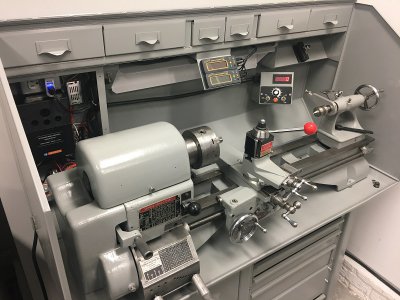
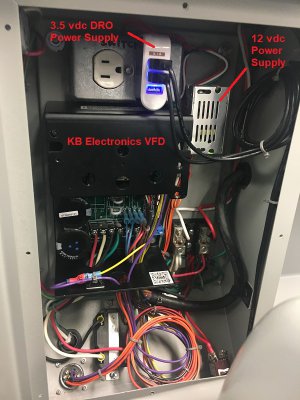
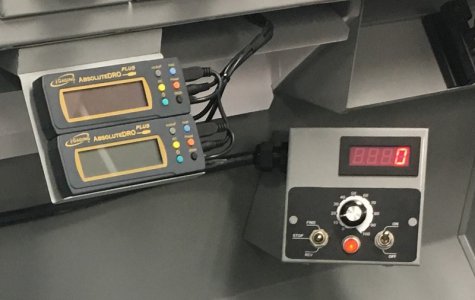
I installed everything with the cable extensions routed as planned, powered up the DROs and they worked just fine……until I turned on the VFD. Then the DROs went crazy. The motor does not have to be running, just the VFD powered up. Upon a little investigation, I may have both a conducted and radiated emission problem.
There is still enough length of the factory iGaging control cables to reach the displays which can be moved and attached anywhere, but not routed in an acceptable manner. So suspecting the cable extensions weren’t adequately shielded, I eliminated the cable extensions…….and DROs still go bonkers when I power up the VFD. I disconnected the power cables and let the DROs revert to battery and problem solved. The extension cables are also routed on top of a 24” LED light which is another potential source of interference, but it doesn’t seem to matter whether that is on or off. I have not pulled the DRO extension cables out to see if rerouting these cables alone will solve the problem but I doubt it. I did have a couple other power cables so I pulled the power supply, plugged it into another 120vac circuit via extension cord, and with the power cables at least 3-4ft from the VFD, the displays still go off the charts when I attach the power supply, but are fine on battery.
So I’m looking for ideas to solve the problem. I sure would like to be able to use my present cable routing, but looking back, if one was trying to create an EMI problem, my scheme looks like a pretty sure way to do it.
I have read several other threads on iGaging noise susceptibility here on the forum, with a motor controller being the noise source. One was solved by a applying a capacitor across the power leads. I’ve inquired in that thread.
Since the factory control cables don’t seem to have a problem, do you think there is there any chance that I could just make a custom cable with good shielding, and the bypass cap across the power leads, and use the same cable routing? Or am I fighting a losing battle with proximity to the VFD?
A couple other tidbits, the iGaging absolute scales are stainless steel, and I believe they are grounded through mounting to the lathe, but I need to double check that because the lathe could be isolated by painted surfaces. All the metal surfaces on the cabinet, back splash, and lathe (tbc) are grounded. The 120 vac power source for everything is connected at a common node in the electrical enclosure….no filtering.
The small regulated 12 vdc power supply in the enclosure provides power for the tachometer. The tach has a magnetic sensor/pick-up located in the lower cabinet and its display and electronics are in the remote VFD panel. There are unshielded multiconductor 18 awg cables to the cabinet and remote panel routed through the electrical enclosure. The tach is completely unaffected and operates normally in all conditions. They are Amazon cheapies. I think the PS was $6 and the tach was $12.
The electrical enclosure looks pretty busy but it’s really only the VFD, and a couple small power supplies….the rest is just connectors and cabling.
Opinions/suggestions welcome.
Best,
Kelly

New Caretaker of Two 12” Craftsman Lathes
Hi all, first post here. I’m the new caretaker of two 12” Craftsman lathes, one with a 42” bed and the other 54”. Though they recently came into my possession they are well known to me. The 42 is model 101.07403 number SN 16014 and the 54 is model 101.07403 SN 22500. The only place I’ve found...
 www.hobby-machinist.com
www.hobby-machinist.com
I used a small chain drag cable carrier for the DRO install to protect the cables. Here is a direct link to the DRO install portion of the thread.

New Caretaker of Two 12” Craftsman Lathes
The 2-Step countershaft pulley has a chip out of the side of the larger groove but it should be OK to use. And the motor pulley is on the shaft of what appears to be a permag DC motor. All of the lathes in the bunch that Lon bought had DC motors, as the lathes were used for large coil and...
 www.hobby-machinist.com
www.hobby-machinist.com



I installed everything with the cable extensions routed as planned, powered up the DROs and they worked just fine……until I turned on the VFD. Then the DROs went crazy. The motor does not have to be running, just the VFD powered up. Upon a little investigation, I may have both a conducted and radiated emission problem.
There is still enough length of the factory iGaging control cables to reach the displays which can be moved and attached anywhere, but not routed in an acceptable manner. So suspecting the cable extensions weren’t adequately shielded, I eliminated the cable extensions…….and DROs still go bonkers when I power up the VFD. I disconnected the power cables and let the DROs revert to battery and problem solved. The extension cables are also routed on top of a 24” LED light which is another potential source of interference, but it doesn’t seem to matter whether that is on or off. I have not pulled the DRO extension cables out to see if rerouting these cables alone will solve the problem but I doubt it. I did have a couple other power cables so I pulled the power supply, plugged it into another 120vac circuit via extension cord, and with the power cables at least 3-4ft from the VFD, the displays still go off the charts when I attach the power supply, but are fine on battery.
So I’m looking for ideas to solve the problem. I sure would like to be able to use my present cable routing, but looking back, if one was trying to create an EMI problem, my scheme looks like a pretty sure way to do it.
I have read several other threads on iGaging noise susceptibility here on the forum, with a motor controller being the noise source. One was solved by a applying a capacitor across the power leads. I’ve inquired in that thread.
Since the factory control cables don’t seem to have a problem, do you think there is there any chance that I could just make a custom cable with good shielding, and the bypass cap across the power leads, and use the same cable routing? Or am I fighting a losing battle with proximity to the VFD?
A couple other tidbits, the iGaging absolute scales are stainless steel, and I believe they are grounded through mounting to the lathe, but I need to double check that because the lathe could be isolated by painted surfaces. All the metal surfaces on the cabinet, back splash, and lathe (tbc) are grounded. The 120 vac power source for everything is connected at a common node in the electrical enclosure….no filtering.
The small regulated 12 vdc power supply in the enclosure provides power for the tachometer. The tach has a magnetic sensor/pick-up located in the lower cabinet and its display and electronics are in the remote VFD panel. There are unshielded multiconductor 18 awg cables to the cabinet and remote panel routed through the electrical enclosure. The tach is completely unaffected and operates normally in all conditions. They are Amazon cheapies. I think the PS was $6 and the tach was $12.
The electrical enclosure looks pretty busy but it’s really only the VFD, and a couple small power supplies….the rest is just connectors and cabling.
Opinions/suggestions welcome.
Best,
Kelly
Last edited:



